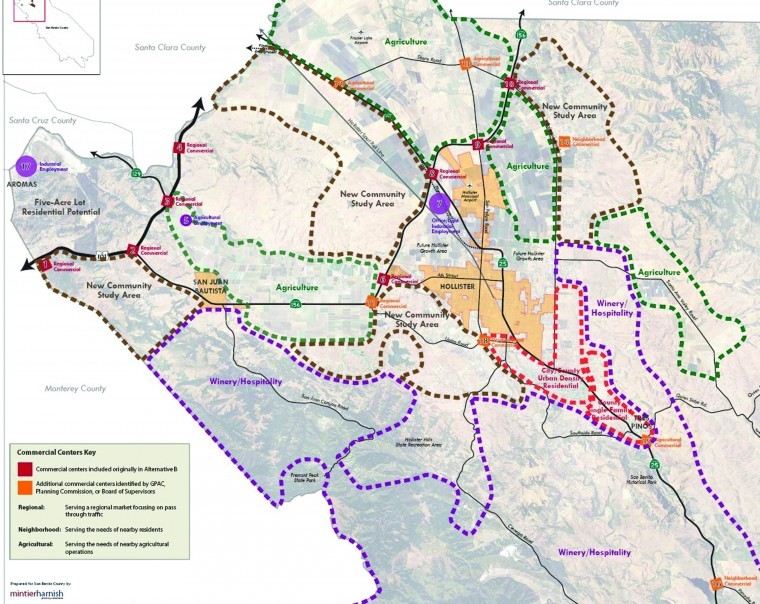Planning Director Gary Armstrong talked with county supervisors about the general plan update at last week’s meeting at the request of Supervisor Anthony Botelho and told the board it has entered its final stages of development.
“It creates a long-range, big picture,” Armstrong said, of the planning document that has been in the works since 2007. “It sets goals and policies. The general plan is long term and very general. It is into the final stages.”
The general plan will provide a guideline for growth in San Benito County through 2035.
Armstrong said the document was ready to move forward into the public review stage, but the supervisors had a few more decisions to make before going ahead as well as plenty of questions for Armstrong and the consultants.
“Option one is to proceed to public review and incorporate county comments,” Armstrong said. “Option two is to revise the plan to include the northern region highway traffic studies. It would have a ripple effect throughout the document. There is no budget allotted to perform this.”
Supervisors heard from both the planning consultant and traffic consultants, including that traffic studies could require an additional $50,000 to $100,000 of work and would delay the plan update by up to three months. Jim Harnish, the project manager with consulting firm Mintier Harnish, said including the information from the recent traffic studies would affect other sections of the report such as greenhouse gas emissions. He said it may require editing in most sections of the document.
“Unfortunately, the document is a snapshot in time,” Armstrong said. “We started it in 2007.”
Armstrong said that although portions of the document may be outdated by the time it is adopted, the important parts of the document are the policies that guide the decisions in the future.
The supervisors supported lowering the road level of service required by the general plan from level C to level D, a classification used by traffic engineers to describe traffic flow. The example discussed at the meeting included Highway 25 at level C and D. At level C, parts of the highway would require six lanes when the county reaches its build out capacity. At level D, parts of the highway would require four lanes instead.
Public Works Director Steve Wittry asked that the supervisors might not make a broad decision on the level of service without looking at the impact of the change. The supervisors agreed to have the consultants and staff bring information forward at a future meeting, potentially in 30 days.
Community service areas
The document includes some areas marked as new community study areas. They are mostly within 10 to 15 minutes of Hollister. The areas are listed as unplanned development because at this time the property owners have not provided any plans for developments, with the exception of San Juan Oaks. Armstrong said the burden of doing environmental impact reports to show the areas can provide infrastructure – such as roads, water access, sewer access and other needs without negatively affecting wildlife or environmental needs – will be on developers.
“We want to make sure they are not seen in a negative light, but we are acknowledging that they need to do their own environmental work,” Armstrong said.
Botelho said he worried that highlighting certain parts of the county in the study areas might create a “sense of entitlement or at least the perception” of it for those swaths of land.
Armstrong said future development is not limited to the areas highlighted as new community study areas, but property owners in other parts of the community could also submit applications.
“I want the areas to be encouraging of growth, not discouraging of growth,” Supervisor Jerry Muenzer said.
Scott Fuller, of San Juan Oaks, expressed the same concerns, though he said he had not seen the wording in the document yet.
“I would suggest a third alternative to recheck the edits to make sure there isn’t anything in the EIR that treats the new community study areas as unplanned growth,” he said. “Update it. We want to make sure it is not seen in a negative light.”
At the end of the discussion, the supervisors gave direction to the staff to look at updating the level of service for roadways from level C to D but not to do a revision based on updated traffic numbers.
“We are six weeks from getting it on the street to the public,” Harnish said.
Harnish did note that the consultants encountered a few unexpected costs, such as tweaking the traffic model from AMBAG. He said they have $30,000 left. He informed supervisors that it may be difficult to complete the work for that amount, depending on how many public comments come in during the review period.
Supervisor Margie Barrios stressed that she would have wanted to information on the extra expenses earlier in the process.










